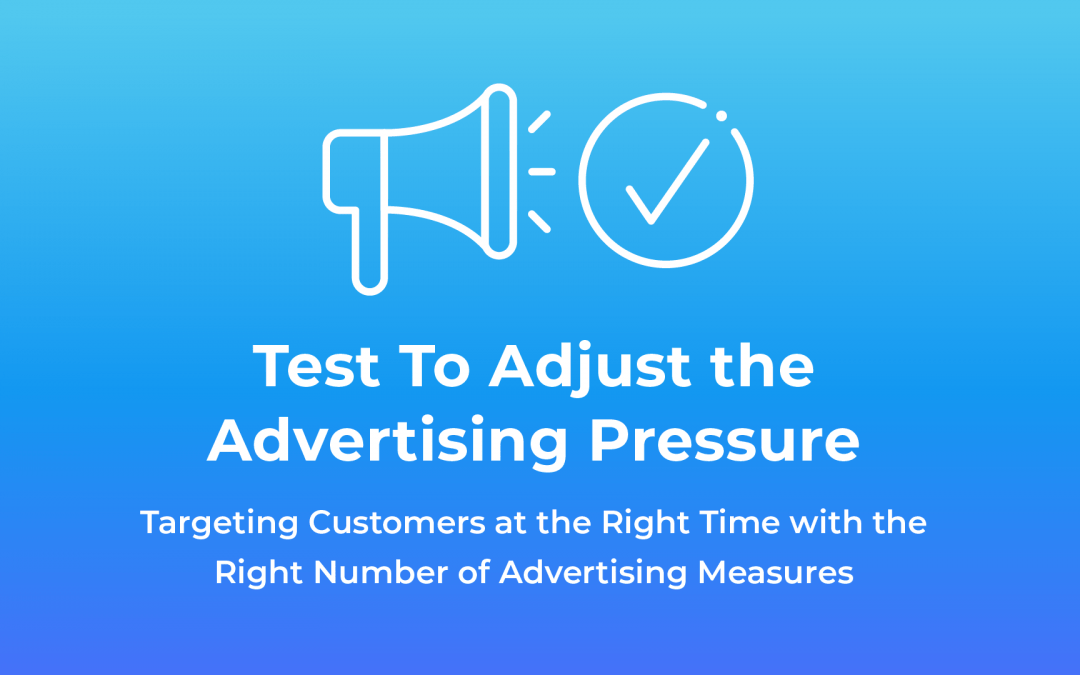Less Advertising Does Not Necessarily Mean Fewer Sales
Customers, especially those who buy regularly, often receive a lot of advertising impulses, which are associated with corresponding costs for the advertising company. This is particularly true for print mailings and paid social campaigns. But newsletter campaigns also involve costs for newsletter sign-ups (for example acquisition costs, etc). In the case of voucher campaigns, a lower contribution margin represents a further cost factor.
But more advertising impulses do not always lead to more purchases. Quite the opposite, in fact: in current practice, many customers often receive more advertising media than is necessary. The advertising pressure (the extent to which a target group is confronted with advertising media) of these customer groups tends to be too high so that the effect of each additional advertising impulse decreases.
However, the costs for these advertising impulses remain constant. So the revenue generated with these customers is therefore often accompanied by excessively high advertising costs. Thereby, reducing the number of advertising impulses does not necessarily lead to fewer purchases.
In the following article, you will learn how to determine the ideal number of advertising impulses for your customers.
How Often Should Customers Receive an Advertising Impulse?
The importance of a sophisticated chain of advertising impulses gets evident by looking at the following figure:
The orange line represents approximately the advertising pressure and its’ peaks the advertising impulses. The peaks of the blue curve on the other hand show when purchases happened.
In the figure, there are eight advertising impulses. Three times a purchase was made. The comparison of the two lines shows at first glance that the timing of a purchase is related to the advertising measures because the purchases occurred in each case shortly after receipt of an advertising impulse.
Optimally, advertising media should only be sent out to customers who need an advertising impulse to buy. The aim should therefore be to determine the optimum advertising pressure for each customer. However, for statistical reasons, it is not possible to determine the optimum advertising pressure for each customer individually.
Anyway, using the CrossEngage Customer Prediction Platform (CPP), it is possible to predict for individually defined customer groups the probable revenue or the probable conversion rate for each customer.
Test, Test, Test!
Different advertising impulse chains can be used to provide different customer groups with different advertising pressure. This leads to exciting insights: For example, which customer groups react to different levels of advertising pressure.
This approach is what we call a “test for adjusting advertising pressure.” It is a test concept that can be used to analyze the effects of an advertising pressure adjustment. In the process, one part of the customers is sent the previous impulse chain – the previous advertising media at the usual frequency.
The other part of the customers is sent an adapted advertising impulse chain. This differs exactly by one feature: For example, the number of advertising impulses that these customers receive. If it is assumed that the customer base is currently receiving too many advertising pushes, a smaller number of advertising pushes should be provided for the adjustment.
A Large Monetary Lever Often Exists
The test is relevant because it often reveals a very high optimization potential with great monetary leverage. Commonly, customers who buy very frequently are targeted with too many expensive advertising impulses.
Ideal conditions for carrying out such a test and subsequently optimizing costs are a dense advertising impulse chain with regular advertising impulses that come along with high advertising costs (as already described above, for example, print, newsletter, social paid, or voucher campaigns). When assessing costs, both direct and indirect costs (for example, newsletter sign-up costs) should be taken into account.
The Testing Concept
The basic idea of the test setup is to compare the group of customers addressed with the adjusted advertising impulse chain (test group) and the other group with the previous standard chain (control group). It is possible to test several adapted impulse chains at the same time, but we recommend not to let the test become too complex. The following figure shows a possible test concept with a reduced advertising impulse chain and the standard one.
At the beginning of the test, the customers are randomly assigned to one of those two impulse chains. The customers remain in the same group for the entire duration of the test. Furthermore, the following three factors must be taken into account for a successful test:
Determining the Test group Sizes
How many customers of a customer group will continue to receive the usual advertising media and how many customers will receive the adapted ones?
Design of the Adjusted Impulse Chain
Which advertising impulses will be omitted/added to the adjusted impulse chain?
Determining the Test Period
How long should be the test period?
1. Determining the Test Group Sizes
The test groups do not have to be of equal size (50/50). It is also possible to divide the groups according to proportions such as 70/30 or 80/20. However, the test group must be at least large enough so that statistically significant differences between the individual impulse chains can be determined at the end of the test period.
%
Whether a customer group is large enough to be statistically significant can be calculated with the Sample Size Calculator.
2. Designing the Adjusted Impulse Chain
At the beginning of such a test, it has to be decided which of the advertising impulses should be omitted in an adjusted impulse chain. In previous projects of CrossEngage in which the test has been conducted, employees’ experience in the respective companies has played a major role in deciding this question. You should pay attention to two things:
- It should be ensured that the content and the frequency of the reduced impulse chain continue to have an advertising effect on the customers.
- Too few omitted advertising impulses reduce the chance of obtaining an insightful test result. Too many omitted advertising impulses, however, could at the same time reduce the potential sales generated with the customers.
3. Determining the Test Period
The test is intended to show the medium-term effects of a changed advertising strategy. For this reason, a test period of at least half a year is generally recommended. The test period can be somewhat shorter for business models with a very high average number of transactions per customer, and correspondingly longer for those with very few average transactions.
What Should Be Considered in the Evaluation?
The test can only be properly evaluated after the test period has expired. The main objective of the evaluation should be to determine and compare the contribution margin (revenue subtracted with advertising costs) achieved in the test period in both advertising impulse chains.
The evaluation itself is extremely simple by comparing the respective contribution margins of the test group and the control group. Afterwards, you know whether you generated more, the same amount, or less contribution margin with the adjusted impulse chain. Then, you can incorporate these findings into your marketing strategy.
In our experience, an adjustment of an impulse chain has different effects in different customer groups. Another goal of the evaluation should therefore also be to identify these differences between the various customer groups. Examples of characteristics of the respective groups are:
- Score classes (grouping of customers based on their CLV forecast)
- A/B/C customer analyses (grouping according to sales and importance)
- Purchase channels (e.g. differentiation between online and print customers)
- Age
- Geography
- Other
It is highly recommended to compare the behavior of individual customer groups in addition to the overall comparison. But here, too, it is important not to forget the statistical significance of the groups. If you know in advance which customer groups you want to differentiate in retrospect, you should take this into account when determining the test group sizes.

Success Story:
Atelier Goldner Schnitt x CrossEngage
Atelier Goldner Schnitt (AGS) is a mail-order company for high-quality women’s fashion established in 1926. The main focus of marketing is on customer-centric print mailings and newsletter emails. The company has been working successfully with CrossEngage for many years.
AGS creates predictive models to evaluate future Customer Lifetime Values (CLV) in the CrossEngage Customer Prediction Platform (CPP). With the resulting CLV-scores of each customer, marketing decisions can be made – which customers should optimally receive which offer at which time via which channel. AGS now uses over 200 predictive models from the CPP live, in parallel and fully automated.
Together with CrossEngage, the multi-channel retailer set up the test for adjusting advertising pressure, because they assumed a big potential for cost optimization by omitting print mailings. The goal was to acknowledge to which extent AGS should omit print mailings in which customer audiences.
Through long-term testing, AGS discovered customer groups where a decrease in advertising pressure resulted in no or only minimal revenue declines. For the company, this was an important piece of the puzzle in a major transformation away from the scattergun approach (“We regularly write to all customers in the same way”) to a customer-centric approach (“A customer receives the right offer from us via the right channel at the right time”).
The results look good: By specifically omitting certain print mailings to the appropriate customer groups, the mail-order company was able to make massive cost savings while maintaining the same level of sales and thus achieved an increase in the contribution margin of over € 1,000,000 over the entire test period.

